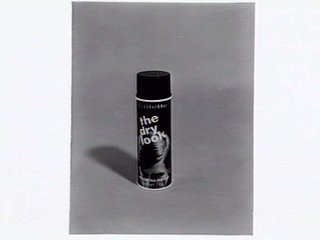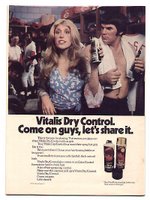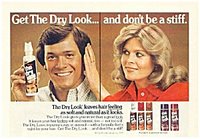The Dry Look
 In the early 1970s, Gillette introduced The Dry Look, a revolutionary hairspray for men who'd adopted 1960s' fashion preference for longer, natural hairstyles yet who wanted to keep that "natural," blown-dry hair looking unnaturally neat and flowing just so over their early 1970s' wide shirt collars and long sideburns. Remember the old split-screen tv commercial that ran in the early '70s? The "then" version of the man in the ad, with his Brylcreem-gobbed hair, was portrayed as downbeat and most likely impotent. The "now" version of this gentleman was cool and ready for action, ready for more action than any one man should have been able to handle! Who needed Viagra in the '70s? A full head of long, dry, yet tidy hair was all a man needed to get back on the horse. You think Andrew Stevens ever had problems in the sack? Doubtful. Variations on this commercial would ensue.
In the early 1970s, Gillette introduced The Dry Look, a revolutionary hairspray for men who'd adopted 1960s' fashion preference for longer, natural hairstyles yet who wanted to keep that "natural," blown-dry hair looking unnaturally neat and flowing just so over their early 1970s' wide shirt collars and long sideburns. Remember the old split-screen tv commercial that ran in the early '70s? The "then" version of the man in the ad, with his Brylcreem-gobbed hair, was portrayed as downbeat and most likely impotent. The "now" version of this gentleman was cool and ready for action, ready for more action than any one man should have been able to handle! Who needed Viagra in the '70s? A full head of long, dry, yet tidy hair was all a man needed to get back on the horse. You think Andrew Stevens ever had problems in the sack? Doubtful. Variations on this commercial would ensue. Remarkably, this ad anticipated the culturally explosive fashion battle that took place during the 1972 World Series, which pitted that the mustachioed, Dry Look-using Oakland A's against the no-facial-hair-mandated, Brylcreem-applying Cincinnati Reds. (Interestingly, Reds star Pete Rose, whose pageboy haircut always threatened the team's rule against hair over the collar, would go on to shill for The Dry Look's main competitor, Vitalis' Dry Control. The cultural implications of "wet" vs "dry" hair would continue through the decade into the early 1980s. Granted, the dry look wasn't for everybody.
Remarkably, this ad anticipated the culturally explosive fashion battle that took place during the 1972 World Series, which pitted that the mustachioed, Dry Look-using Oakland A's against the no-facial-hair-mandated, Brylcreem-applying Cincinnati Reds. (Interestingly, Reds star Pete Rose, whose pageboy haircut always threatened the team's rule against hair over the collar, would go on to shill for The Dry Look's main competitor, Vitalis' Dry Control. The cultural implications of "wet" vs "dry" hair would continue through the decade into the early 1980s. Granted, the dry look wasn't for everybody. Variations on the concept of attaining a "natural" state through artificial means reached new peaks during the bizarre decade that informs many of the overlooked gems of my lifetime. The product, The Dry Look, is still available today, but the instructive image of a man sporting this bold, new look is no longer part of the packaging. Recently, trends in men's hair fashions have moved from a return to the fully wet look to more of a dried wet look, commonly known as "bed head." But who knows? Today's fashion trend is tomorrow's overlooked gem. There are even reports that the dry look is coming back into fashion!
Variations on the concept of attaining a "natural" state through artificial means reached new peaks during the bizarre decade that informs many of the overlooked gems of my lifetime. The product, The Dry Look, is still available today, but the instructive image of a man sporting this bold, new look is no longer part of the packaging. Recently, trends in men's hair fashions have moved from a return to the fully wet look to more of a dried wet look, commonly known as "bed head." But who knows? Today's fashion trend is tomorrow's overlooked gem. There are even reports that the dry look is coming back into fashion!
John Cale, Fear
 For too long I've been delaying writing a profound entry on the backseat gem that is John Cale's 1974 album, Fear. I've had the album, in its cover featuring a harsh, black-and-white, scary yet serene closeup of Cale's large-featured face sitting in front of my stereo for the last month. I've cranked up the album a few times since then. One day I even sat at the piano - an instrument I can't really play - and easily plucked out the chords and basic licks in each song. It was a good way to get further into the slightly overlooked sibling of the "classically trained" Cale's influential and universally acknowledged masterpiece and rock snob rite of passage, the sly, elegant Paris 1919. Few album covers better represent the music that's contained within that the cover for Fear.After the backstory of his founding of the Velvet Underground, which followed time spent receiving "classical training" and later "studying" under avant garde composer LaMonte Young (perhaps the most referenced artist in rock criticism that rock critics have never actually heard [thanks, RTH!]), the leadoff track of Fear, "Fear Is a Man's Best Friend" follows Paris 1919 in intermediate studies in the artist. I won't bore you with further cut-and-pasted details, although some of them, such as Little Feat backing up Cale on his acknowledged masterpiece, are fascinating for folks like myself, folks who can't get enough of this stuff, right down to the participation of rock's forgotten street poet, Garland Jeffreys, on Cale's solo debut, Vintage Violence. I will waste no further words, and get back to the trick that Fear's title track (click and wait out final 25 seconds of the previous song on a WFMU broadcast to listen) pulls off: it far outdoes John Lennon's "Mother" in kicking off an album with rock 'n roll's long-sought primal scream intensity. When the genre of rock 'n roll was created, surely one of its objectives was to allow yon' teens an outlet for letting the world know just how crazy and mixed up their inner lives were. Combine this with existential philosphy, Freudian analysis, and a Neanderthal's sense of reggae rhythms on the chorus, and you've pretty much got the recipe for Cale's very own Scream. Throughout the album, Cale receives major contributions from Roxy Music-pedigreed guitarist Phil Manzanera and knob- and perspective-twiddler Brian Eno. The sound is dry, stark, and menacing. Even the mellow songs, of which there are a handful, have that sense of menace. When he sings, in the stately "Buffalo Ballet", the refrain of "Sleeping in the midday sun...", a less-than-peaceful sleep is promised. The third track in, "Barracuda", is pushed along by a grotesque walking bassline and is punctuated by an oddly placed, descending synth run that comes and goes at just the right time. It's another song that confidently - and almost gleefully - bodes bad tidings. (This is getting at what's made this album so right for me over the years.) Manzanera, under the meddling fingers of Eno, is allowed to run free for much of the album, and that's always a good thing. Side 2 kicks off with a long, repetitive, swaggering number called "Gun". Over the rollicking barroom piano-led rhythm track, Manzanera's guitar wails through all levels of filtered devices. Cale sounds like he means business. Too often, in albums that would follow Fear, Cale "meaning business" would mean Cale exhorting a lot of overwrought horseshit. Check out the dead-on-arrival Slow Dazzle album if you dare. On Fear, however, you get out of the way and let the man through. Maybe it's that sound, a sound that has much more with Roxy Music's For Your Pleasure than any other Cale album or Cale production.So, I procrastinated in writing what I had hoped would be a profound and informative piece on John Cale's Fear. I suspect, as I feared I that would, I have missed the mark. However, as I come to terms with the knowledge that the ocean will have us all, as I play this album, as I learn that there's a time to deflate the balloon I work too hard to maintain, I take solace in and celebrate the dark visions that are put across on this album at just the right pitch for my sensibilities.
For too long I've been delaying writing a profound entry on the backseat gem that is John Cale's 1974 album, Fear. I've had the album, in its cover featuring a harsh, black-and-white, scary yet serene closeup of Cale's large-featured face sitting in front of my stereo for the last month. I've cranked up the album a few times since then. One day I even sat at the piano - an instrument I can't really play - and easily plucked out the chords and basic licks in each song. It was a good way to get further into the slightly overlooked sibling of the "classically trained" Cale's influential and universally acknowledged masterpiece and rock snob rite of passage, the sly, elegant Paris 1919. Few album covers better represent the music that's contained within that the cover for Fear.After the backstory of his founding of the Velvet Underground, which followed time spent receiving "classical training" and later "studying" under avant garde composer LaMonte Young (perhaps the most referenced artist in rock criticism that rock critics have never actually heard [thanks, RTH!]), the leadoff track of Fear, "Fear Is a Man's Best Friend" follows Paris 1919 in intermediate studies in the artist. I won't bore you with further cut-and-pasted details, although some of them, such as Little Feat backing up Cale on his acknowledged masterpiece, are fascinating for folks like myself, folks who can't get enough of this stuff, right down to the participation of rock's forgotten street poet, Garland Jeffreys, on Cale's solo debut, Vintage Violence. I will waste no further words, and get back to the trick that Fear's title track (click and wait out final 25 seconds of the previous song on a WFMU broadcast to listen) pulls off: it far outdoes John Lennon's "Mother" in kicking off an album with rock 'n roll's long-sought primal scream intensity. When the genre of rock 'n roll was created, surely one of its objectives was to allow yon' teens an outlet for letting the world know just how crazy and mixed up their inner lives were. Combine this with existential philosphy, Freudian analysis, and a Neanderthal's sense of reggae rhythms on the chorus, and you've pretty much got the recipe for Cale's very own Scream. Throughout the album, Cale receives major contributions from Roxy Music-pedigreed guitarist Phil Manzanera and knob- and perspective-twiddler Brian Eno. The sound is dry, stark, and menacing. Even the mellow songs, of which there are a handful, have that sense of menace. When he sings, in the stately "Buffalo Ballet", the refrain of "Sleeping in the midday sun...", a less-than-peaceful sleep is promised. The third track in, "Barracuda", is pushed along by a grotesque walking bassline and is punctuated by an oddly placed, descending synth run that comes and goes at just the right time. It's another song that confidently - and almost gleefully - bodes bad tidings. (This is getting at what's made this album so right for me over the years.) Manzanera, under the meddling fingers of Eno, is allowed to run free for much of the album, and that's always a good thing. Side 2 kicks off with a long, repetitive, swaggering number called "Gun". Over the rollicking barroom piano-led rhythm track, Manzanera's guitar wails through all levels of filtered devices. Cale sounds like he means business. Too often, in albums that would follow Fear, Cale "meaning business" would mean Cale exhorting a lot of overwrought horseshit. Check out the dead-on-arrival Slow Dazzle album if you dare. On Fear, however, you get out of the way and let the man through. Maybe it's that sound, a sound that has much more with Roxy Music's For Your Pleasure than any other Cale album or Cale production.So, I procrastinated in writing what I had hoped would be a profound and informative piece on John Cale's Fear. I suspect, as I feared I that would, I have missed the mark. However, as I come to terms with the knowledge that the ocean will have us all, as I play this album, as I learn that there's a time to deflate the balloon I work too hard to maintain, I take solace in and celebrate the dark visions that are put across on this album at just the right pitch for my sensibilities.
 In the early 1970s, Gillette introduced The Dry Look, a revolutionary hairspray for men who'd adopted 1960s' fashion preference for longer, natural hairstyles yet who wanted to keep that "natural," blown-dry hair looking unnaturally neat and flowing just so over their early 1970s' wide shirt collars and long sideburns. Remember the old split-screen tv commercial that ran in the early '70s? The "then" version of the man in the ad, with his Brylcreem-gobbed hair, was portrayed as downbeat and most likely impotent. The "now" version of this gentleman was cool and ready for action, ready for more action than any one man should have been able to handle! Who needed Viagra in the '70s? A full head of long, dry, yet tidy hair was all a man needed to get back on the horse. You think Andrew Stevens ever had problems in the sack? Doubtful. Variations on this commercial would ensue.
In the early 1970s, Gillette introduced The Dry Look, a revolutionary hairspray for men who'd adopted 1960s' fashion preference for longer, natural hairstyles yet who wanted to keep that "natural," blown-dry hair looking unnaturally neat and flowing just so over their early 1970s' wide shirt collars and long sideburns. Remember the old split-screen tv commercial that ran in the early '70s? The "then" version of the man in the ad, with his Brylcreem-gobbed hair, was portrayed as downbeat and most likely impotent. The "now" version of this gentleman was cool and ready for action, ready for more action than any one man should have been able to handle! Who needed Viagra in the '70s? A full head of long, dry, yet tidy hair was all a man needed to get back on the horse. You think Andrew Stevens ever had problems in the sack? Doubtful. Variations on this commercial would ensue. Remarkably, this ad anticipated the culturally explosive fashion battle that took place during the 1972 World Series, which pitted that the mustachioed, Dry Look-using Oakland A's against the no-facial-hair-mandated, Brylcreem-applying Cincinnati Reds. (Interestingly, Reds star Pete Rose, whose pageboy haircut always threatened the team's rule against hair over the collar, would go on to shill for The Dry Look's main competitor, Vitalis' Dry Control. The cultural implications of "wet" vs "dry" hair would continue through the decade into the early 1980s. Granted, the dry look wasn't for everybody.
Remarkably, this ad anticipated the culturally explosive fashion battle that took place during the 1972 World Series, which pitted that the mustachioed, Dry Look-using Oakland A's against the no-facial-hair-mandated, Brylcreem-applying Cincinnati Reds. (Interestingly, Reds star Pete Rose, whose pageboy haircut always threatened the team's rule against hair over the collar, would go on to shill for The Dry Look's main competitor, Vitalis' Dry Control. The cultural implications of "wet" vs "dry" hair would continue through the decade into the early 1980s. Granted, the dry look wasn't for everybody.

